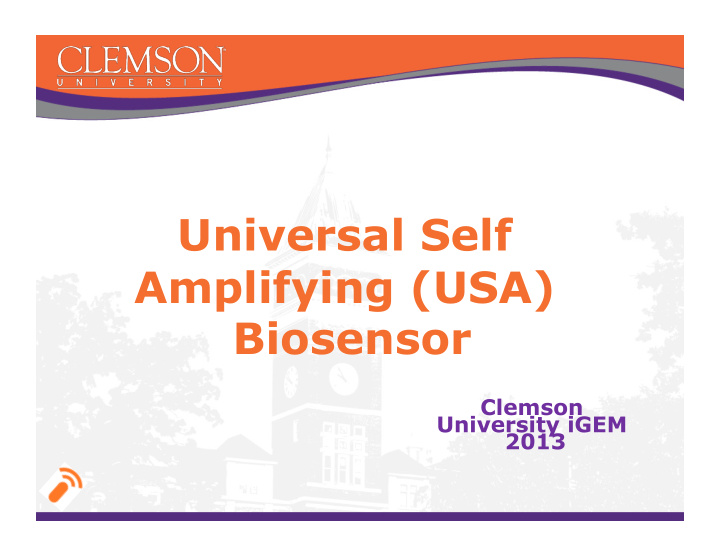



Universal Self Amplifying (USA) Biosensor Clemson University iGEM 2013
Outline • Introduction • USA Biosensor System • Results • Future work • Human practices • Questions
Foodborne Pathogens • Center for Disease Control (CDC) estimates that each year roughly 1 in 6 Americans (or 48 million people) gets sick, 128,000 are hospitalized, and 3,000 die of foodborne diseases. • Department of Defense (DoD) food safety and QA action levels require zero tolerance for the following pathogens: Esherichia coli O157:H7, Salmonella , Staphylococcus , and Listeria monocytogenes *2011 estimates of foodborne illness in the united states. (2011, April 15). Retrieved from http://www.cdc.gov/features/ dsfoodborneestimates/
Foodborne Pathogens • Some possible pathogens are allowed low levels of CFU/g such as some species of E. coli, which has a limit of 100 CFU/g • Limitation with PCR detection – Not able to differentiate between live or dead cells • Current methods (Biological or Immunoassay) suffer – Limited detection usually between 1,000-10,000 CFU/g. Most DoD food safety limits of microorganisms like species of E. coli (100 CFU/g) fall bellow this detection range. – Require sample enrichment in order to detect – Only qualitative not quantitative
Our Project: Universal Self Amplifying (USA) Biosensor • USA System to optimize pathogen detection: – Increased pathogen specificity – No pathogen enrichment – Detection of lower CFU per ml or g – Viable cells only – High sample volume capacity – Simple step detection
Model Pathogen USA Biosensor AHL SAM System RFP AHL LuxI DT luxI rfp RBS RBS Universal Self-Amplifying Biosensor P Lac AHL SAM AHL GFP LuxR LuxI LuxR DT DT gfp luxI luxR LuxR RBS RBS RBS P Lux P Cat
Results
BioBrick Submitted • MP grown on minimal medium supplemented with glucose or lactose to test effect upon lac promoter
UB & USA-B Response to AHL • Increased GFP emission over time as expected
UB & USA-B Response to Model Pathogen • Increased GFP emission over time as expected • The higher concentrations of the AHL-producing K1090000 resulted in higher GFP signal
UB & USA-B With All Three • Excess AHL produced the highest GFP fluorescence as expected • However, non-AHL producing model pathogen and AHL- producing model pathogen produced almost the same results: as the bacteria grew, the GFP fluorescence increased
Conclusions • All four constructs on a Petri plate: MP, RFP, UB, and USA-B • USA-B has constitutive GFP expression regardless of AHL presence
Future Work Biosensor • Further develop enzymatic construct • Improve promoter stringency • Determine optimal detection rate • Evaluate efficiency of multiple copies of regulator, co-inducer, and reporter • Develop unique (synthetic) signaling system
Future Work Pathogen--Signal Construct • Replace AHL with unique signal under pathogen- specific promoter Phage • Construction of lysogenic bacterial phage – Specific to pathogen
Human Practices Clemson Elementary School • two 4 th grade classes • “bad” bacteria vs. “good” bacteria • Very curious and imaginative • Will return and play games
Human Practices Pendleton High School • Spoke to 3 classes of juniors and seniors • Had good discussions about the ethics of genetic engineering • Science teachers wanted us to return to teach as a part of general biology
Human Practices Student Survey Clemson University – iGEM Survey: Before • Surveyed the students 1. Have you ever heard of Synthetic Biology? Yes before and after the No presentation 2. What is your opinion on genetic engineering? Strongly Negative 1 2 3 4 5 6 7 Strongly Positive • Had a sample size of 44 3. What is your opinion on genetically modified organisms? Strongly Negative 1 2 3 4 5 6 7 Strongly Positive students 4. Does it change your opinion when they are called GMOs? Yes • Used yes/no responses No and 7-point scales for 5. If you could modify a bacterium to perform a task or solve a problem what would the organism be able to do? qualitative responses A. Degrade pollutants B. Improve food safety C. Detect pathogens D. Produce energy useable by humans E. All of the above F. None of the above G. Other H. If other, please specify below:
Human Practices Average Opinion Before and After 7 6 5 4 before 3 after 2 1 0 genetic engineering GMOs
Clemson iGEM Team 2013
Questions?
Recommend
More recommend